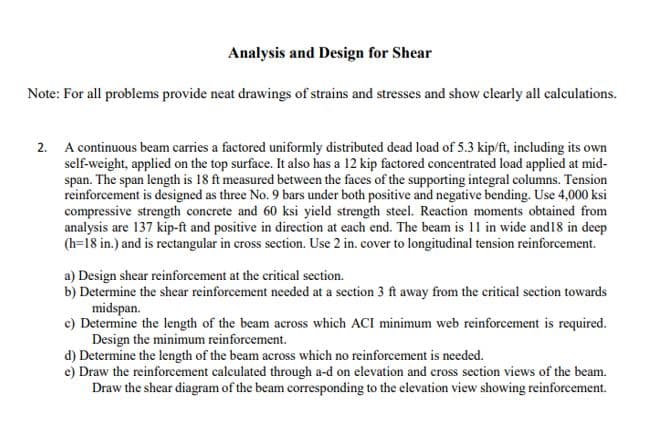Analysis and Design for Shear Note: For all problems provide neat drawings of strains and stresses and show clearly all calculations. 2. A continuous beam carries a factored uniformly distributed dead load of 5.3 kip/ft, including its own self-weight, applied on the top surface. It also has a 12 kip factored concentrated load applied at mid- span. The span length is 18 ft measured between the faces of the supporting integral columns. Tension reinforcement is designed as three No. 9 bars under both positive and negative bending. Use 4,000 ksi compressive strength concrete and 60 ksi yield strength steel. Reaction moments obtained from analysis are 137 kip-ft and positive in direction at each end. The beam is 11 in wide and 18 in deep (h=18 in.) and is rectangular in cross section. Use 2 in. cover to longitudinal tension reinforcement. a) Design shear reinforcement at the critical section. b) Determine the shear reinforcement needed at a section 3 ft away from the critical section towards midspan. c) Determine the length of the beam across which ACI minimum web reinforcement is required. Design the minimum reinforcement.
Analysis and Design for Shear Note: For all problems provide neat drawings of strains and stresses and show clearly all calculations. 2. A continuous beam carries a factored uniformly distributed dead load of 5.3 kip/ft, including its own self-weight, applied on the top surface. It also has a 12 kip factored concentrated load applied at mid- span. The span length is 18 ft measured between the faces of the supporting integral columns. Tension reinforcement is designed as three No. 9 bars under both positive and negative bending. Use 4,000 ksi compressive strength concrete and 60 ksi yield strength steel. Reaction moments obtained from analysis are 137 kip-ft and positive in direction at each end. The beam is 11 in wide and 18 in deep (h=18 in.) and is rectangular in cross section. Use 2 in. cover to longitudinal tension reinforcement. a) Design shear reinforcement at the critical section. b) Determine the shear reinforcement needed at a section 3 ft away from the critical section towards midspan. c) Determine the length of the beam across which ACI minimum web reinforcement is required. Design the minimum reinforcement.
Chapter2: Loads On Structures
Section: Chapter Questions
Problem 1P
Related questions
Question

Transcribed Image Text:Analysis and Design for Shear
Note: For all problems provide neat drawings of strains and stresses and show clearly all calculations.
2. A continuous beam carries a factored uniformly distributed dead load of 5.3 kip/ft, including its own
self-weight, applied on the top surface. It also has a 12 kip factored concentrated load applied at mid-
span. The span length is 18 ft measured between the faces of the supporting integral columns. Tension
reinforcement is designed as three No. 9 bars under both positive and negative bending. Use 4,000 ksi
compressive strength concrete and 60 ksi yield strength steel. Reaction moments obtained from
analysis are 137 kip-ft and positive in direction at each end. The beam is 11 in wide and 18 in deep
(h=18 in.) and is rectangular in cross section. Use 2 in. cover to longitudinal tension reinforcement.
a) Design shear reinforcement at the critical section.
b) Determine the shear reinforcement needed at a section 3 ft away from the critical section towards
midspan.
c) Determine the length of the beam across which ACI minimum web reinforcement is required.
Design the minimum reinforcement.
d) Determine the length of the beam across which no reinforcement is needed.
e) Draw the reinforcement calculated through a-d on elevation and cross section views of the beam.
Draw the shear diagram of the beam corresponding to the elevation view showing reinforcement.
Expert Solution
This question has been solved!
Explore an expertly crafted, step-by-step solution for a thorough understanding of key concepts.
This is a popular solution!
Trending now
This is a popular solution!
Step by step
Solved in 2 steps with 1 images

Knowledge Booster
Learn more about
Need a deep-dive on the concept behind this application? Look no further. Learn more about this topic, civil-engineering and related others by exploring similar questions and additional content below.Recommended textbooks for you


Structural Analysis (10th Edition)
Civil Engineering
ISBN:
9780134610672
Author:
Russell C. Hibbeler
Publisher:
PEARSON

Principles of Foundation Engineering (MindTap Cou…
Civil Engineering
ISBN:
9781337705028
Author:
Braja M. Das, Nagaratnam Sivakugan
Publisher:
Cengage Learning


Structural Analysis (10th Edition)
Civil Engineering
ISBN:
9780134610672
Author:
Russell C. Hibbeler
Publisher:
PEARSON

Principles of Foundation Engineering (MindTap Cou…
Civil Engineering
ISBN:
9781337705028
Author:
Braja M. Das, Nagaratnam Sivakugan
Publisher:
Cengage Learning

Fundamentals of Structural Analysis
Civil Engineering
ISBN:
9780073398006
Author:
Kenneth M. Leet Emeritus, Chia-Ming Uang, Joel Lanning
Publisher:
McGraw-Hill Education


Traffic and Highway Engineering
Civil Engineering
ISBN:
9781305156241
Author:
Garber, Nicholas J.
Publisher:
Cengage Learning